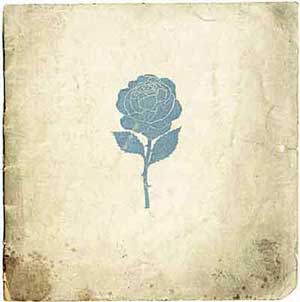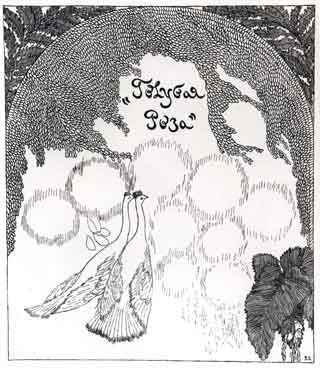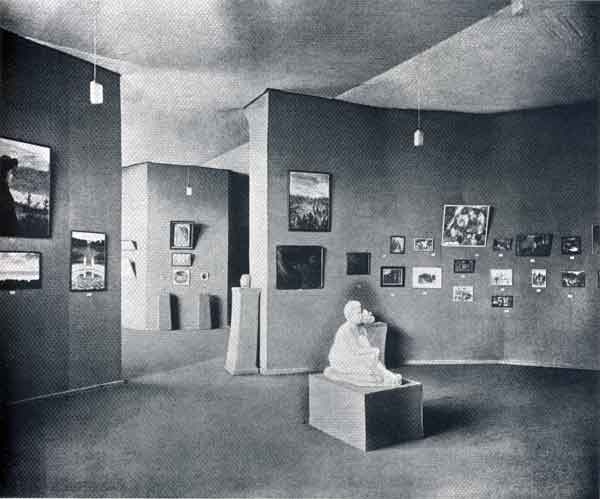The Blue Rose - Golubaya Rosa - Голубая Роза
1907 - 1912, Member List
Following in the path of the World of Art group, the Union of Russian Artists (Soyuz Russkikh Khudozhnikov), and the Brotherhood of Moscow Artists (Bratstvo Moskovskikh Khudozhnikov), new artistic movements and groups were founded, becoming particularly active around 1905. These forerunners of the Avant-garde continued the search for a new, contemporary way to express themselves, as the 1910s were becoming a time of complexity and contradiction. Former values were overthrown to be replaced by new theories and counter-theories. The pace of artistic life increased dramatically, techniques and styles changing swiftly during these pre-Revolutionary years.

Cover for exhibition catalogue of
the the Blue Rose group. 1907.
The Crimson Rose exhibition, organized in Saratov in 1904, was named after the symbol of hope, youth and earthly passion, as described by the philosopher Solovyev, and united artists connected with the Russian Symbolist movement. Pavel Kuznetzov and Piotr Utkin, who organized it, invited Sergei Sudeikin, Nikolai Sapunov and others to participate. Their teachers, Vrubel and Borissov-Mussatov, were also presented. Utkin’s Night (1904) was typical, showing the connection between Russian Symbolism and Art Nouveau. Here, framed by golden leaves, night-birds fly in and an eagle claws at a duck in a vision of nature made complex through its symbolism.
Symbolists were close to the masters of the World of Art in their presentation of an ambiguous, twilight world. Their references to folklore also reflected the interests of the Abramtsevo Circle. They seemed to sense the possibility of transition from the real world to an imaginary, more meaningful one, and strove towards simplicity and restraint in which the tremulous feeling of nature is nevertheless preserved.

P.Utkin. Title page for a set of reproductions
"Exhibition of the the Blue Rose"
in the journal "The Golden Fleece", #5, 1907.
In Moscow in 1907 Kuznetzov, Utkin, Saryan, Sapunov, Sudeikin, Krymov and Arapov mounted the Blue Rose exhibition. Blue, the color of the sky, of water and of boundless space held a symbolic meaning for these artists. They encouraged a mystical interpretation, combining poetic dream with reality, sadness and hope. The Blue Rose artists where closely connected with the Symbolist poets and writers in Moscow who were associated with the journals "The Balance" and "The Golden Fleece". According to the theories of Viacheslav Ivanov, Alexandr Block, Andrei Bely and other Symbolists, reality was but a stimulus, a starting point for the artistic image. The Blue Rose artists have, accordingly, invented their own world, combining fantasy and childhood dreams, feelings of foreboding and a sense of the supernatural to allow poetic imagination to soar above reality.
These Symbolists artists also attempted to absorb into painting techniques from other arts. Musical and poetic associations were expressed through rhythm, movement, texture and color. They strove towards new principles, meant to crystallize in the work of the later radical movements.
The Blue Rose group was the first to be united by a single esthetic approach, yet each artist retained his individuality. Saryan’s work has the clear decorative and romantic Eastern fable, and Sapunov’s Dance (from 1912) with its earthly and infernal passions, contrasting dark tones and bright lights with tragic foreboding. Sudeikin’s "The Big Wheel" (from 1910) is characteristically theatrical. Lively and whimsical, it points to the tragi-comedy of existence.
However, this playful world could not substitute reality for long, and artists of the Blue Rose soon re-evaluated their position.
By the end of the 1920s Kuznetzov, the former leader of this group, had achieved a new harmony in the eternal themes of his Eastern Kyrghyz series. He achieves perfection through a harmony of composition and color, and reality here is completely embodied in the visionary world of the artist.

Exhibition of the Blue Rose group. One of the exposition halls. 1907.
